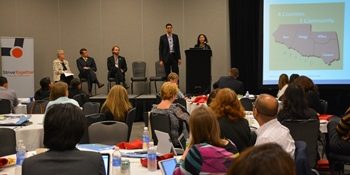Continuous quality improvement (CQI) has become a hot topic for many of us in the social sector.
While continuously improving seems like a rather easy concept to understand, CQI requires more than just acknowledging the significance of these words. Instead, it requires ownership of the concept by both individuals and communities.
I have learned the importance of internalizing CQI and bridging the gap between theory and practicality through our work leading a cohort of StriveTogether Cradle to Career Network communities working to apply CQI practices in their efforts to increase FAFSA (Free Application for Federal Student aid) completions.
Project FAFSA launched in January 2015, with a goal of increasing FAFSA completion rates by four percent or an additional 2,220 students across seven participating cradle to career partnerships, including Seeding Success in Memphis, Tennessee; Bridging Richmond in Richmond, Virginia; RGV Focus in Rio Grande Valley, Texas; Mission: Graduate in Albuquerque, New Mexico; the Big Goal Collaborative in Northeast Indiana; the Learning Network of Greater Kalamazoo in Michigan; and StrivePartnership in Cincinnati, Ohio / Northern Kentucky.
With support from Lumina Foundation, StriveTogether has been working with these communities to analyze key drivers impacting FAFSA completion rates, develop improvement action plans and measure progress in real time in order to improve. They joined us to dig deep, set goals and work collectively to not only increase FAFSA completion rates locally, but to embed a culture of continuous quality improvement within their own communities and partners.
Each of the seven communities has walked away with invaluable knowledge on how to continuously improve FAFSA completion rates. But, more importantly, they learned some key lessons that will help build a culture of continuous quality improvement in their communities:
- Data does not always illustrate unidentified best practices, which can serve as valuable feedback on how to move forward in practical manners. During Project FAFSA, collective impact partnerships learned how to establish a collective goal, how to identify partners required for implementation, and how to navigate access to student level data.
- Partnerships also gained valuable skills around embedding the Plan-Do-Study-Act (PDSA) process on both micro and macro levels, how to compel community wide ownership, and how to communicate their information.
- CQI is about improving what you are already doing. It would be counterproductive to review results, make assumptions and move on to the next strategy. Modeling a culture of continuous quality improvement requires an intentional approach to studying how we implement strategies in real time. Communities engaged in Project FAFSA learned to be intentional about pausing to take a closer look at what they are doing that directly or indirectly affects our intended results.
As of June 30, 2015, FAFSA completion rates have increased by 1.8 percent across the cohort, with 26,816 FAFSA applications completed by the seven communities. While we must celebrate Seeding Success for achieving a 27 percent increase in Memphis alone, lessons learned throughout the collaborative speak volumes about the power of striving for improvement.
The natural tendency is to look at these results and assume that not much has changed. However, if we look a little bit deeper, it is clear that communities engaged in Project FAFSA can challenge this mindset. The power that comes from internalizing CQI lessons helps us bridge the gap between theory and practically.
To quote the very wise Thomas Edison, “I am not discouraged, because every wrong attempt discarded is another step forward.” It is safe to say, the knowledge gained through Project FAFSA helps us all take another step in the right direction that is worth celebrating.
Photo: Maria Esther Rodriguez and Daniel Tesfay with RGV Focus share lessons learned during a panel discussion on Project FAFSA at the 2015 StriveTogether Post-Secondary and Career Success for Every Student Convening.




